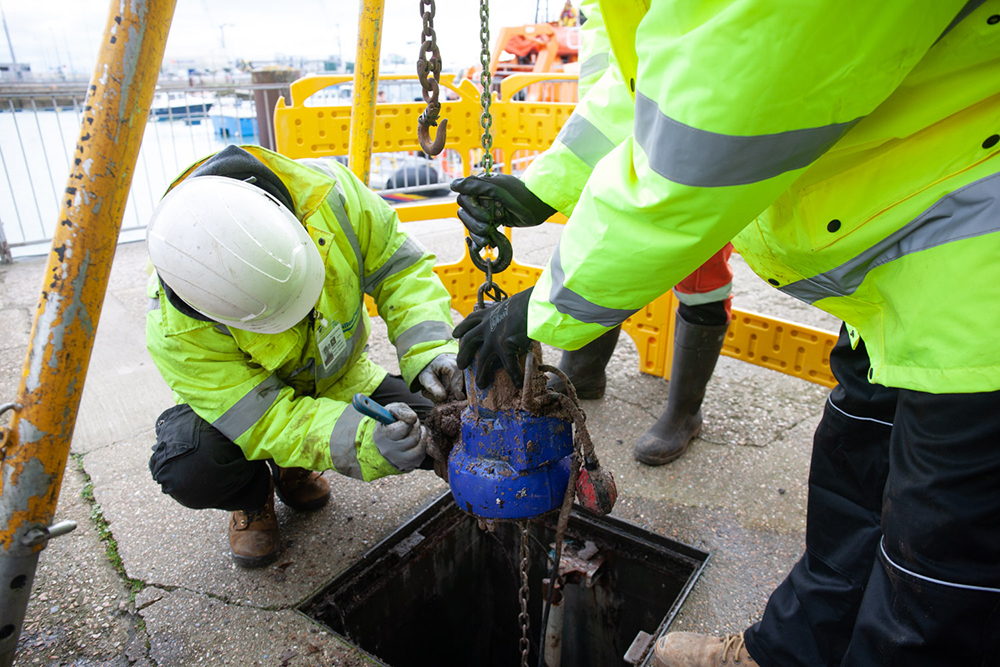
This CPD, in association with Metro Rod, considers the role of submersible pumps in the construction sector, the importance of expert consultancy in the design and installation of pumps, and the threat posed to our drainage systems by climate change.
Adoptable and private pump stations are now a fundamental part of any modern-day build project. As efforts to minimise flooding across the UK gain momentum due to Sewerage Sector Guidance changes and the introduction of legislation such as The Environment Bill, there will be more responsibility to ensure infrastructure and communities are protected. Construction teams, pump manufacturers and water authorities must work closely together and ensure pumps play an efficient and sustainable role.
There are currently 112 internal drainage boards in England, operating and maintaining some 22,000 kilometres of watercourse, including associated sluices and weirs, and hundreds of pumping stations to help manage water levels. However, as more private entities increase their use of drainage pumps in the blueprints of their developments to help reduce the flood risk, they look set to become an even more prominent feature of UK drainage infrastructure.
Drainage and wastewater pumps can be installed underground to remove wastewater from a range of domestic and industrial sites, including private housing, farmland, and construction sites. In short, in any location where the land is lower than the main sewer invert, a pump station or treatment plant will be required to remove sewage.
Main sewer pipes use gravity to move surface water and sewage, allowing the fluid to flow gradually downhill until it reaches the lowest possible point. A pump comes into play underground when gravity can no longer be relied upon. Once activated, the installed pump will efficiently and economically pump the fluid to the main sewer inlet.
Every single build project is different, and as such, the design of every pump station should be as well. Plus, as the impact of climate change becomes ever more complex and the risk of flooding continues to increase, applying a blanket approach to the design and installation of pump stations simply isn’t recommended.
With this in mind, at the conceptual stages of any building project, it’s essential to understand how pump stations will be beneficial to the operation of a finished development, taking into account the size of the development and what specification the pump station comes under.
The pump station must be designed to either Sewerage Sector Guidance (SSG) and local water authority addendum specifications if the station is to be adopted or Building Regulations Part H1 if it’s to remain private. It’s of vital importance to understand what specification is needed as this will determine the size of the pump station required.
Types of pump stations
GRP (glass reinforced plastic) pump station
Also known as a package pump station or submarine tank.
This is a chamber that is dropped into a pre-dug hole by groundworkers. They are pre-made off-site, and once in place, a pump engineer will fit the pumps, the control panel and then fit the float switches and set them to the correct operational heights. Before completing the works, they will test & commission the pump station.
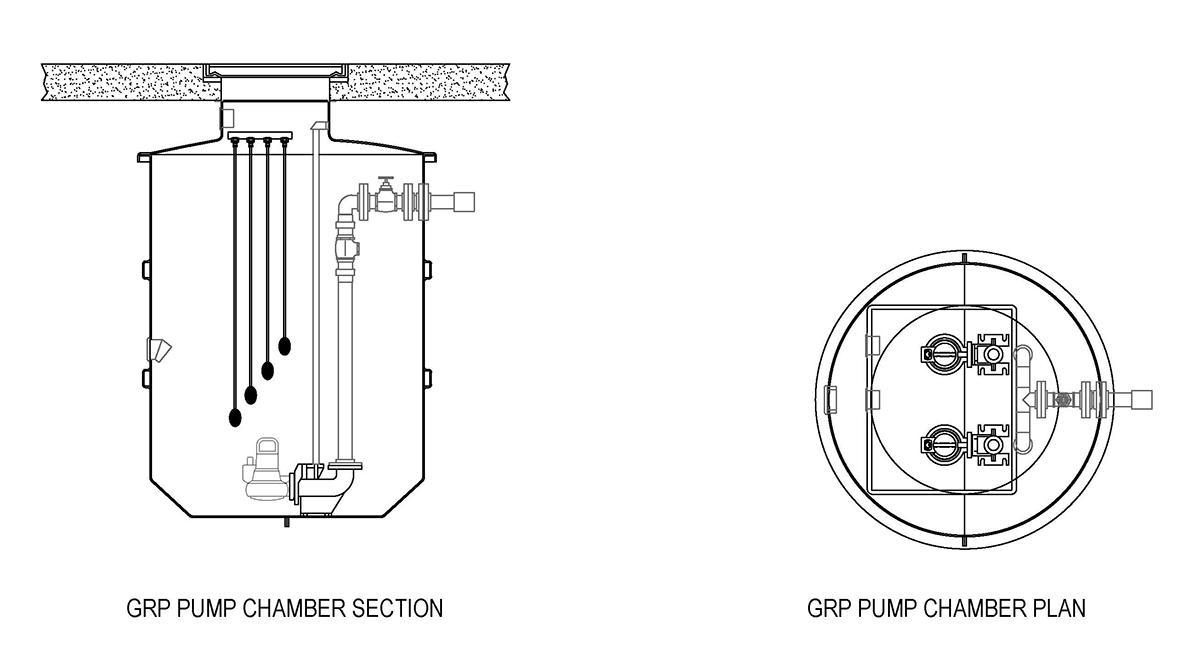
PPC pump station (pre-cast concrete ring station)
Pre-cast concrete rings arrive at the site and are lowered into a pre-dug hole, then secured one on top of the other to create a pump chamber. A two-person pump team would then attend, with signed-off RAMS, to enter the chamber and take measurements before installing the necessary components.
For example, the pump pedestals, guide rails, pipework and valves, and the control panel in a separate kiosk or plant room. Once complete, the float switches are set to the correct operational heights, tested & then commissioned.
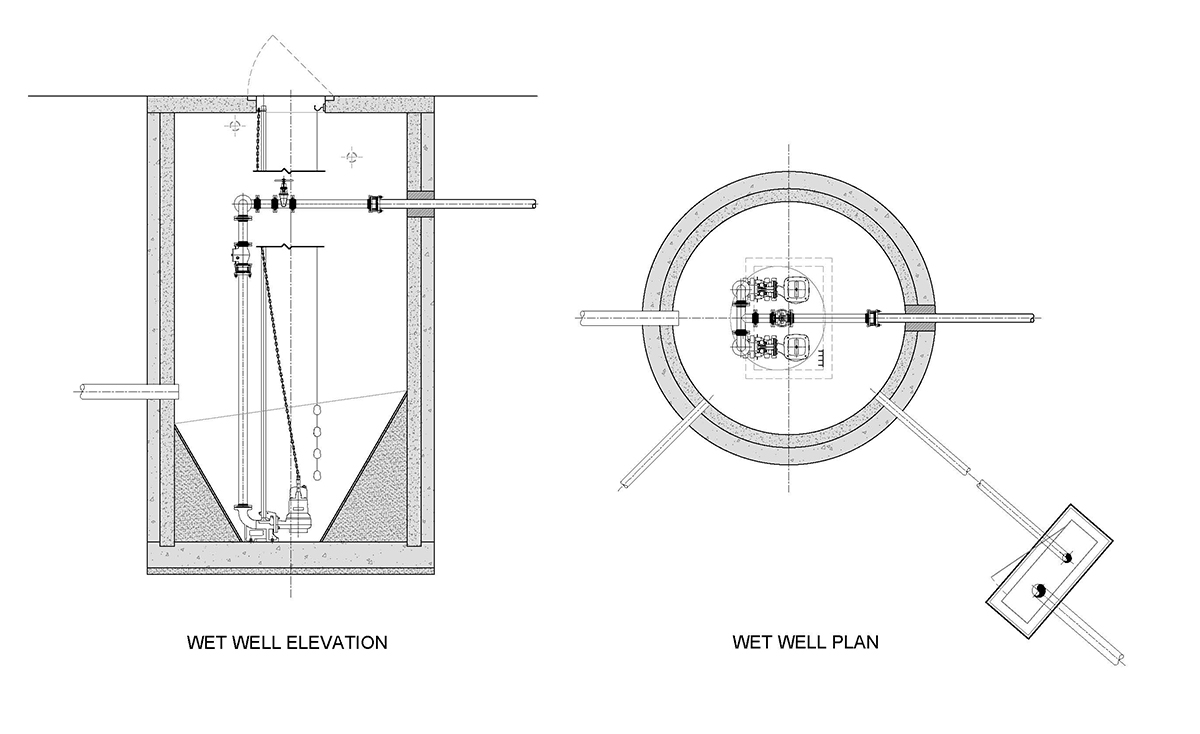
Adoptable pump station
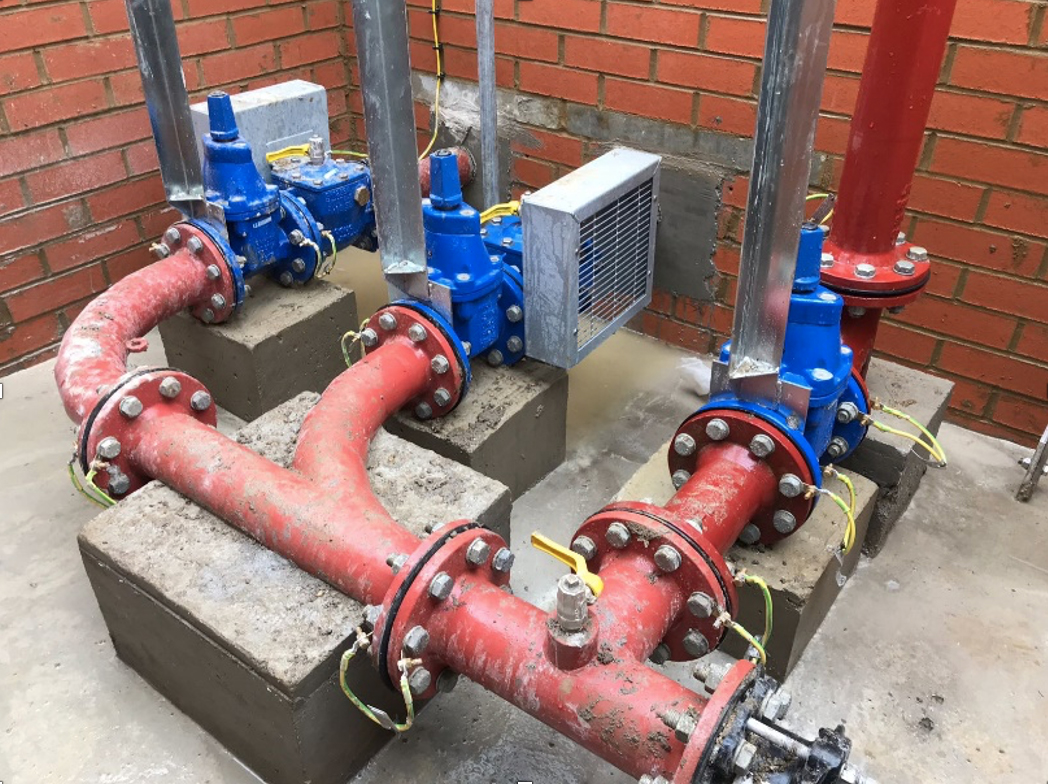
Adoptable pump stations are designed to the latest Sewerage Sector Guidance (SSG) and the local water authority specifications. They require full approval by the adopting water authority before any construction on-site and typically take up a large area, approximately 10m x 14m, dependent on the type required.
Before the water authority can adopt the pump station, more than 51% of the site must be occupied.
Types of pump
Submersible foul/storm pump
Used to pump drainage water or foul water, they ideally work in pairs. When there is foul water, the pumps alternate between active and standby or active and assist depending on the flow rates. Storm pumps, however, are normally set up to alternate between active and assist due to a typically higher than normal flow rate.
Submersible pumps can be fitted with various types of impellers to suit the individual site. For example, a macerator impeller that cuts and shreds debris and adaptive single-channel or multi-channel solids handling impellers. Vortex pumps are another type of submersible pump that have better handling capabilities for solids.
Submersible sump pump
A type of submersible pump that is typically found in basements or below ground car parks, it works by pumping fluid up to the main sewer inlet. Sump pumps use an electric motor component which must be kept above water.
Contractor sump pump
A type of submersible pump typically found on construction sites to remove drainage water while construction takes place.
The effects of flooding on drainage pumps
Climate change is making flooding a more serious threat than ever before. As the risk of flooding increases, so too does the risk of damage to property and the surrounding infrastructure.

As the earth warms, the atmosphere around us holds more moisture. Rising temperatures intensify the water cycle, increasing evaporation. The air can only hold a certain amount of moisture at any given time, and as evaporation increases, rainfall becomes heavier. Already, several regions across the UK experience ‘extreme rainfall’ in summer. The risk of floods is no longer limited to autumn and winter.
And while the immediate focus will be on clearing the disruption caused by flooding, we must also remain vigilant about the impact it has on community infrastructure – and the drainage systems working below ground.
Storm drains and drainage pumps are installed across the UK and are specifically designed to draw water away from roads when heavy rain and flash flooding occurs. During flooding, excess water escapes the streets via gutters and grids. The water enters a storm drainage tank which is split into different holding chambers, each containing a float.
As each chamber fills and reaches capacity, a float will trigger an alarm. The pump will then automatically begin ejecting water into sewer pipes, where it eventually reaches lakes, rivers or reservoirs.
When functioning efficiently, storm drainage systems are able to protect us from the impact of floods, but several factors put that at risk.
Firstly, many aren’t routinely serviced or maintained and become clogged with fallen leaves, litter and silt, which builds up over time. Then, when a storm does hit, the pump isn’t able to cope. Instead, water overflows and pools form on motorways, car parks, and outside businesses and homes.
Additionally, as flooding increases and the capacity of the sewer networks is put at risk, so too is the capacity of drainage pumps. If there’s no space remaining in the main drain, the pump has nowhere to discharge water too. Instead, the pumps become overwhelmed and unable to perform efficiently. Leaving any excess water in a storm drain or drainage pump will eventually wear out the pumps sitting inside the holding chambers, leading to a complex and costly repair.
Finally, any excess water which isn’t able to drain from the sewer network properly can then go on to cause structural damage to the surrounding infrastructure, affecting residential and commercial developments.
As such, it’s vital to ensure pump systems are maintained all year round to make sure that should a flash or extreme flooding event occur, it is best prepared to tackle the ensuing challenges.
The effects of concrete and rubble on pumps
Any building project will generate a wealth of waste material, including concrete, rubble and silt, which developers are required to manage on-site. Despite their best attempts, some of this material can enter nearby drains and therefore, the sewer networks and pump systems below ground.
Whether you use a temporary pump to control any water that’s gathered during excavation, or you install a specified pump intended to support a local community for years to come, consideration must be taken to ensure the build process doesn’t impact the effectiveness of the system.
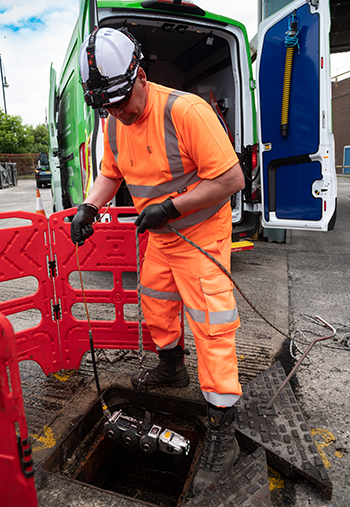
Most excavations below ground level accumulate water so before work starts, plan how to treat and dispose of groundwater that enters the site. A pump to discharge the water to the sewer network may be required and if so, the local environmental regulator will need to be contacted for authorisation. This can take several months to obtain, so planning ahead is vital to prevent disruption.
When installing an underground drainage pump to a site that connects to the local water network, steps will need to be taken to ensure as little waste material as possible enters the sewer. Not only does the waste itself pose a blockage risk, but some materials can contaminate the water, which then ends up in the watercourse, reaching people’s homes and businesses.
To avoid this happening, ensure your pump system has an interceptor installed. They are designed to stop contaminated substances from reaching our drinking water supply. Interceptors are often overlooked but are essential pieces of equipment to prevent cross-contamination.
Additionally, whenever a project is finished, a CCTV drainage survey should be carried out and the drainage system should be thoroughly cleaned, using high-pressure drain jetting. CCTV drain surveys allow for the easy identification and surveying of potential problems that may arise by using high tech, specially designed cameras that identify the source of a potential problem before any larger symptoms occur. Meanwhile, drain jetting uses high-pressure water jets to remove blockages caused by debris build-up to maintain a healthy drainage system.
The life cycle of a drainage pump
Consider the process of integrating a pump station into the project as a life cycle – from initial assessment through design, approval, installation and maintenance. While that might seem overwhelming when dealing with the usual challenges of working on a construction site – time delays, additional costs, managing client relationships – there are industry partners available to ensure anything pump-related embeds seamlessly into your project.
The right partner should take the time to understand the key objectives of the project, give confidence you’re meeting all the necessary requirements in terms of legislation and Sewerage Sector Guidance, and provide a full written M&E specification and technical drawing which outlines the exact makeup of the system.
Even at the initial conceptual stage of having a pump designed and installed, an ongoing, planned, proactive maintenance schedule should be agreed with the pump supplier to ensure the system doesn’t experience failure. Services should be conducted quarterly, six-monthly or annually, and an emergency call out provision should be put in place for extreme circumstances.
For further advice and guidance on the design, installation or maintenance of a pump station, contact Metro Rod on 01625 507 945 or visit Metrorod.co.uk




